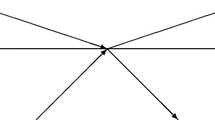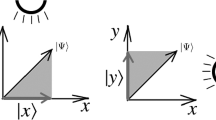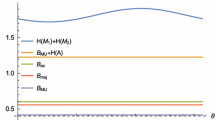Abstract
The aim of these lectures is to investigate the transfer of information occurring in course of quantum interactions. In particular, I shall explore circumstances in which such an information transfer with the quantum environment of the considered quantum system leads to the destruction of the phase coherence between the states of the privileged basis in the system Hilbert space. This basis shall be called the pointer basis. I shall argue that states of this pointer basis correspond to the “classical” states of the observables of the quantum system in question.
[Heisenberg] . . remarks . . that even in the case of microscopic phenomena we may say, in a certain sense, that they are created by repeated observations. . .
[Niels Bohr1, in 1928 Nature article]
Access this chapter
Tax calculation will be finalised at checkout
Purchases are for personal use only
Preview
Unable to display preview. Download preview PDF.
Similar content being viewed by others
References
N. Bohr, The quantum postulate and the recent development of atomic theory, Nature 121: 580–590 (1928).
W. Heisenberg, Über den anschaulichen Inhalt der quanten theoretischen Kinematik und Mechanik, Z. Physik 43:172–198 (1927); English translation, The physical content of quantum kinematic and mechanics, to appear in: “Quantum Theory and Measurement,” J.A. Wheeler and W.H. Zurek, Princeton University Press (1982).
J. von Neumann, “Mathematical Foundations of Quantum Mechanics”, translated by R. T. Beyer, Princeton University Press (1955).
A. Einstein, B. Podolsky and N. Rosen, Can quantum-mechanical description of physical reality be considered complete?, Phys. Rev.47:777–780 (1935)
E. Schrödinger, Die gegenwärtige Situation in der Quanten mechanik, Naturwiss. 23:807–812; 823–828; 844–849 (1935); English translation, The present situation in quantum mechanics.
J. D. Trimmer in: Proc. Am. Phil. Soc. 124:323–338 (1980).
N. Bohr, Discussion with Einstein on epistemological problems in atomic physics, in: “Albert Einstein: Philosopher- Scientist,” P. A. Schilpp, ed., The Library of Living Philosophers, Evanston (1949).
F. London and E. Bauer, “La théorie de 1’observation en Mécanique quantique,” Hermann, Paris ( 1939 ); English translation “The Theory of Observation in Quantum Mechanics” to appear in “Quantum Theory and Measurement,” J. A. Wheeler and W. H. Zurek, Princeton University Press (1982).
H. D. Zeh, On the irreversibility of time and observation in quantum theory, in: “Foundations of Quantum Mechanics,” B. D’Espagnat, ed., Academic Press, New York (1971).
E.P. Wigner, Review of the quantum mechanical measurement problem, preprint based on a lecture delivered by E. P. Wigner at Los Alamos, June 1981. See also E. P. Wigner, this volume, and references therein.
D. Bohm, “Quantum Theory”, Prentice-Hall, New York (1951).
V. B. Braginsky and A. B. Manukin, “Measurement of Weak Forces in Physics Experiments,” University of Chicago Press, Chicago (1977).
K. S. Thorne, R. W. P. Drever, C. M. Caves, M. Zimmermann, and V. D. Sandberg, Quantum nondemoltion measurements of harmonic oscillators, Phys. Rev. Lett. 40:667–671 (1978)
C. M. Caves, K. S. Thorne, R. W. P. Drever, V. D. Sandberg, and M. Zimmermann, On the measurement of a weak classical force coupled to a quantummechanical oscillator, Rev. Mod. Phys. 52:341–392 (1980); see also C. M. Caves, this volume, and references therein.
W. G. Unruh, Quantum nondemolition and gravity wave detection, Phys. Rev. D 19:2888–2896 (1979), see also W. G. Unruh, this volume.
H. Everett III, “Relative State” formulation of quantum mechanics, Rev. Mod. Phys.29:454–462 (1957).
H. P. Yuen, this volume.
I. Prigogine, C. George, F. Henin, and L. Rosenfeld, A unified formulation of dynamics and thermodynamics, Chemica Scripta 4: 5–32 (1973).
S. W. Hawking, Breakdown of predictability in gravitational collapse, Phys. Rev. D 14:2460–2473 (1976).
R. Penrose, Time asymmetry and quantum gravity, to appear in “Quantum Gravity II, A Second Oxford Symposium,” Oxford University Press, Oxford (1982).
E. P. Wigner, Remarks on the Mind-Body question, in “The Scientist Speculates,” I. J. Good, ed., Heinmann, London (1961).
M. O. Scully, R. Shea and J. D. McCullen, State reduction in quantum mechanics: A calculational example, Phys. Reports 43:485–498 (1978).
M. O. Scully, this volume, and references therein.
J. A. Wheeler, The “past” and the “delayed choice” double slit experiment, in: “Mathematical Foundations of Quantum Theory,” Academic Press, New York (1978).
J. A. Wheeler, Frontiers of time, in: “Problems in the Foundations of Physics”, N. Toraldo di Francia, ed., North Holland, Amsterdam (1979).
H. S. Green, Observation in quantum mechanics, Nuovo Cimento 9: 880–889 (1958).
J. A. Wheeler, The “past” and the “delayed choice” double slit experiment, in: “Mathematical Foundations of Quantum Theory,” Academic Press, New York (1978).
H. S. Green, Observation in quantum mechanics, Nuovo Cimento 9: 880–889 (1958).
A. Daneri, A. Loinger and G. M. Prosperi, Quantum theory of measurement and ergodicity conditions, Nuclear Phys. 33: 297–319 (1962).
A. Daneri, A. Loinger and G. M. Prosperi, Quantum theory of measurement and ergodicity conditions, Nuclear Phys. 33: 297–319 (1962).
F. Haake and W. Weidlich, A model for measuring process in quantum theory, Z. Phys. 213:451–465.
G. G. Emch, On quantum measurement processes, Helv. Phys. Acta 45:1049–1056 (1972).
G. G. Emch, On quantum measurement processes, Helv. Phys. Acta 45:1049–1056 (1972).
R. W. Zwanzig, Statistical mechanics of irreversibility, in “Lectures on Theoretical Physics” 3:106–141, Wiley- Interscience, New York (1961).
H. D. Zeh, On the interpretation of measurement in quantum theory, Found Phys. 1: 69–76 (1970).
B. S. DeWitt and N. Graham, eds., “The Many-World Interpretation of Quantum Mechanics” Princeton University Press, Princeton (1973).
C. H. Shannon and W. Weaver, “The Mathematical Theory of Communication,” University of Illinois Press, Urbana (1949).
B. D’Espagnat, “Conceptual Foundations of Quantum Mechanics” Benjamin, Reading, Mass. (second edition, 1976 ).
R. Balescu, chapters 14–17 in “Equilibrium and Nonequilibrium Statistical Mechanics,” Wiley-Interscience, New York (1975).
D. Deutsch, Quantum theory as a universal physical theory, Phys. Rep., submitted.
P. Bocchieri and A. Loinger, Quantum recurrence theorem, Phys. Rev. 107:337–338 (1957).
L. Lugiato, this volume.
S. Stenholm, this volume.
S. Machida and M. Namiki, Theory of measurement in quantum mechanics, Progr. Theor. Phys. 63:1457–1473 and 1833–1847 (1980).
H. Araki, A remark on Machida-Namiki theory of measurement, Progr. Theor. Phys. 64:719–730 (1980).
N. Bohr, Can quantum-mechanical description of physical reality be considered complete?, Phys. Rev. 48:696–702 (1935).
Author information
Authors and Affiliations
Editor information
Editors and Affiliations
Rights and permissions
Copyright information
© 1983 Plenum Press, New York
About this chapter
Cite this chapter
Zurek, W.H. (1983). Information Transfer in Quantum Measurements: Irreversibility and Amplification. In: Meystre, P., Scully, M.O. (eds) Quantum Optics, Experimental Gravity, and Measurement Theory. NATO Advanced Science Institutes Series, vol 94. Springer, Boston, MA. https://doi.org/10.1007/978-1-4613-3712-6_5
Download citation
DOI: https://doi.org/10.1007/978-1-4613-3712-6_5
Publisher Name: Springer, Boston, MA
Print ISBN: 978-1-4613-3714-0
Online ISBN: 978-1-4613-3712-6
eBook Packages: Springer Book Archive




